#afrografiteiras
Photo

🐸🍀 #frogdog #frogs #froggy_explorers #froggy #frogang #froga #frogandtoadarefriends #afrogirlfitness #afrogirl #afrogoth #afrogirls #afrografiteiras #frogbikes #frogband #frogbread #frogbit #frogbutt #bfrog #bfrogdtiys100 #bfrögledammar #bfrogs #bfrogg #frogcycles #frogcult #frogcollection #cfrog #cfrogsdtiys #cfrogs #froggos #kermitmemes🐸 (hier: Froschteich) https://www.instagram.com/p/CEzOveIKVIv/?igshid=19kgdwbv2vp01
#frogdog#frogs#froggy_explorers#froggy#frogang#froga#frogandtoadarefriends#afrogirlfitness#afrogirl#afrogoth#afrogirls#afrografiteiras#frogbikes#frogband#frogbread#frogbit#frogbutt#bfrog#bfrogdtiys100#bfrögledammar#bfrogs#bfrogg#frogcycles#frogcult#frogcollection#cfrog#cfrogsdtiys#cfrogs#froggos#kermitmemes🐸
3 notes
·
View notes
Text
#Fundo NAMI - Anita Hap
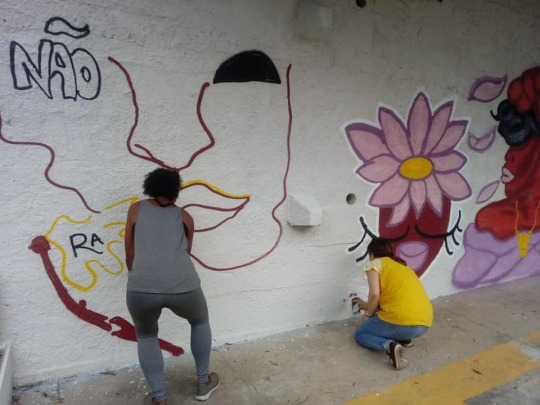


Local: Universidade Estácio de Sá, Campus João Uchôa.
Grafiteiras: Anita Hap, Natalia de Souza e irene Eurolean.
Data: 06 de dezembro de 2019
Sprays utilizados: 61 latas de spray
Metros quadrados pintados: 50 m²
1 note
·
View note
Photo
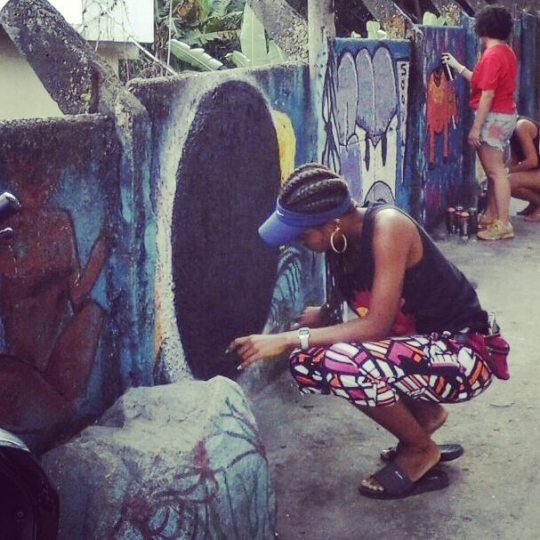
Graffiti work 🖌 #afrografiteiras #redenami #work #graff #graffitirj #tavaresbastos (em Tavares Bastos)
1 note
·
View note
Photo

Bom dia∴ #radioblacktime #serfeliz #violêncianão #bomdia🌞 #músicaboa #noar #n1musicblack #blackpop #n1musicanegra #art #afrografiteiras (em Radio Black Time) https://www.instagram.com/p/Bqcf1SWhns6/?utm_source=ig_tumblr_share&igshid=1uxg4468cw4al
#radioblacktime#serfeliz#violêncianão#bomdia🌞#músicaboa#noar#n1musicblack#blackpop#n1musicanegra#art#afrografiteiras
0 notes
Photo

#afrografiteiras . #nycstreetphotography #Graphitiart #circa2015 #streetart #nyc #artisnewyork #artislife
0 notes
Photo
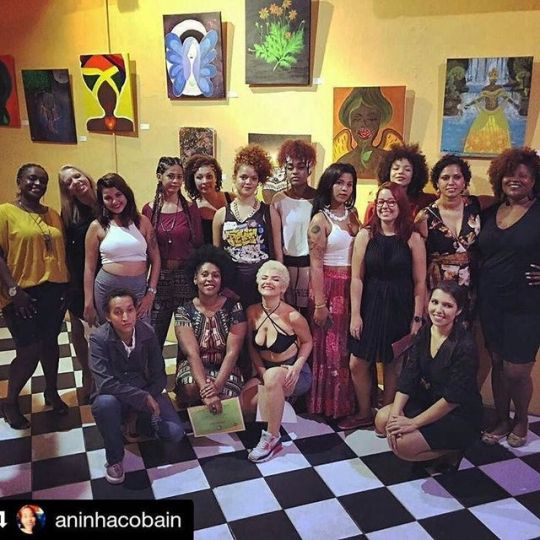
Sintam o peso dessa foto. Adoro meu trabalho. Laçamento do Report Bienal da @redenami com Exposição de formatura da #AfroGrafiteiras #ClarasNunes. #pretaresiste #graffiti #artfeminist #mulherespoderosas #powergirl (em Mangue Seco)
0 notes
Photo

No dia do grafiti vai ter foto e grafite sim! Vai ter preta na rua e na arte. Memória do início na streetart. #vilaalianca#afrografiteiras #streetart
0 notes
Photo

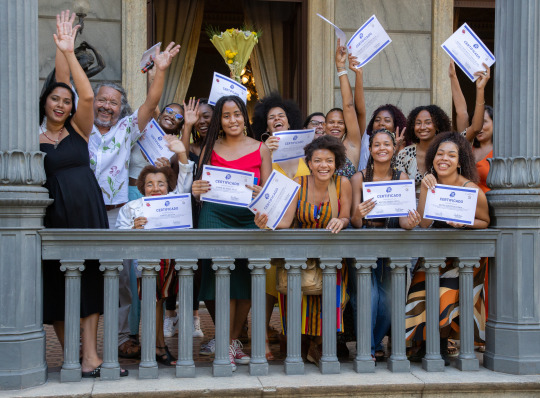
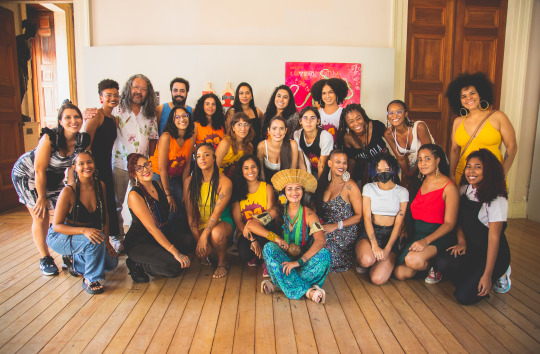

Domingo, dia 1º de maio de 2022, aconteceu a abertura da exposição "Pertencer e Mudar", com curadoria de Priscila Rooxo. A exposição, que contou com artistas convocades a partir de uma chamada aberta e também com alunas que participaram do programa #AfroGrafiteiras de 2021, está em exibição no Museu da República (Catete, Rio de Janeiro) até o dia 29 de maio de 2022.
Na ocasião do evento, que aconteceu no feriado do Dia do Trabalhador, as alunas participantes do programa receberam seus certificados de participação, reiterando o compromisso da Rede NAMI em formar novos agentes que sejam responsáveis pelas mudanças que queremos.
As lideranças de mulheres negras, indígenas, com deficiência, pessoas trans e travestis, se fazem cada vez mais urgentes, e é a partir do entendimento da arte enquanto ferramenta de transformação que a Rede NAMI forma não apenas artistas, mas também educadoras, cientistas, pesquisadoras e inclusive políticas, vide o caso de Joyce Trindade, ex-aluna do #AfroGrafiteiras e que está atualmente como Secretária da Mulher na cidade do Rio de Janeiro.
Joyce esteve presente na abertura da exposição e foi responsável pela entrega dos certificados para as alunas, inspirando uma nova geração de pessoas a ocupar os espaços de decisão e poder.
---
Sunday, May 1, 2022, it happened the opening of the exhibition "To belong and to change", commissioned by Priscila Rooxo. The exhibition, which featured artists invited from an open call and also students who participated in the 2021 #AfroGrafiteiras program, is on display at The Republic Museum (Catete, Rio de Janeiro) until May 29, 2022.
On the occasion of the event, which took place on the Labor Day holiday, the students participating in the program received their participation certificates, reiterating the Rede NAMI's commitment to training new agents who are responsible for the changes we want.
The black, indigenous, with disabilities women and trans people leadership are becoming increasingly urgent, and it is from the understanding of art as a tool of transformation that Rede NAMI trains not only artists, but also educators, scientists, researchers and even politicians, as the case of Joyce Trindade, a former student of #AfroGrafiteiras and who is currently the Women's Secretary in the city of Rio de Janeiro.
Joyce was present at the opening of the exhibition and was responsible for delivering the certificates to the students, inspiring a new generation of people to occupy the decision-making and power spaces.
1 note
·
View note
Text
“Trilhando histórias” nas bibliotecas das unidades Sesc entre os dias 13 e 22 de dezembro
http://www.piscitellientretenimentos.com/trilhando-historias-nas-bibliotecas-das-unidades-sesc-entre-os-dias-13-e-22-de-dezembro/
“Trilhando histórias” nas bibliotecas das unidades Sesc entre os dias 13 e 22 de dezembro
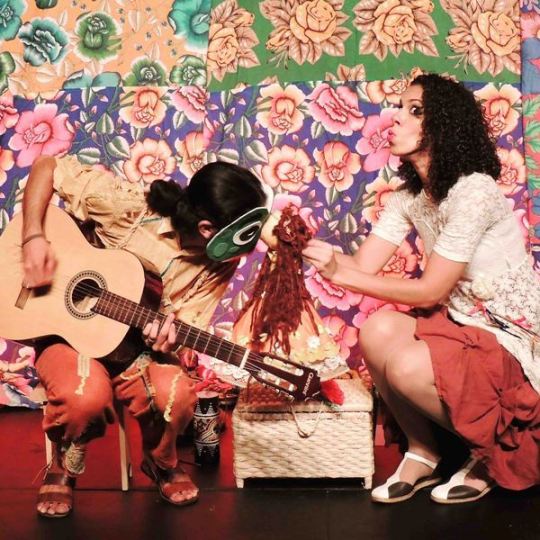
Projeto Primeiros Olhares terá contos populares, cirandas e brincadeiras de roda que fazem a transição de um conto para outro, trupe leva contação de histórias teatralizadas com músicas ao vivo.
Foto Augusto Pessoa – Divulgação
As bibliotecas das unidades Sesc Campos, Barra Mansa, Tijuca, Niterói e São Gonçalo recebem a partir do dia 13 de dezembro o projeto “Sesc Primeiros Olhares” com o espetáculo teatral “Trilhando Histórias” da Cia Trilhos.
Fomentando a literatura, o evento GRATUITO, leva aos públicos infantil, adolescente e adulto, o teatro e a música, através da prática milenar de contar histórias usando o teatro como um universo de imaginação e descobertas.
A estreia acontece dia 13 de dezembro no Sesc Campos, dia 14 de dezembro, Sesc Barra Mansa, 20 de dezembro no Sesc Tijuca, 21 de dezembro no Sesc Niterói e por último, dia 22 no Sesc São Gonçalo. Em cada unidade do Sesc, haverá duas sessões, a primeira às 10h e a segunda às 14h.
A trupe apresenta um espetáculo cujas narrativas são baseadas em contos populares, lendas, parlendas e cirandas. Com músicas ao vivo, histórias como “O sapo e a princesinha” – em que uma princesa bem mal humorada deixa sua bola cair num lago. Um sapo a devolve com a promessa de que ficaria junto da mocinha durante o dia todo.
“A história do Padeiro” – Em uma terra distante, um esperto padeiro cria uma maravilhosa massa para o seu pão que é tão gostosa, mas tão gostosa, que chama a atenção de todos na cidade. O problema foi que tanta fama, fez com que o coitado do padeiro tivesse o seu prazer transformado em obrigação, e aí, vamos precisar descobrir como ele resolve essa história.
“Mário Marinheiro” – Conta a história que um marinheiro não aguentando mais viver no mar, resolve construir sua vida na terra, mas ele acaba entrando em várias aventuras e descobertas . Será que Mario algum dia voltará a navegar?
“Os Músicos de Bremen” – Um burro, um cachorro, um gato e um galo, maltratados pelos seus donos, fogem e se esbarram pelas ruas e juntos decidem ganhar a vida como músicos na cidade de Bremen. Será que os novos amigos conseguirão chegar a essa cidade?
“A ideia do projeto é democratizar e difundir o conhecimento tendo na arte educação e cultura a base para a produção e construção do nosso trabalho; acreditamos que a produção teatral possa despertar e desenvolver o resgate dos valores e tradições particulares à oralidade e influenciar a formação de público, de leitores e escritores.” Afirma Mitat Marques.
Para Rômullo Moraes, nos dias atuais é necessário promover o resgate da cultura popular brasileira através da literatura folclórica e regional, proporcionar a reflexão acerca da cidadania e dos direitos sociais fundamentais junto às crianças e adolescentes.
Sobre a Cia. Trilhos
Criada há dois anos, a Cia. Trilhos acredita que a inquietude e experimentação são os ativadores do trabalho, que através de rodas de contação de histórias, musicalização e interpretação, aliadas às práticas em arte educação, prospectam a vivência, a cultura, os patrimônios materiais e imateriais, e a memória, assim como o resgate e disseminação dos valores e tradições particulares à oralidade. Busca a inclusão, reconhecimento e pertencimento. Formada pelos atores Mitat Marques e Rômullo Moraes, a companhia conta com a produtora cultural, gestora de negócios e projetos, Maiara Viana Rodrigues, e o diretor e coordenador artístico, Augusto Pêssoa.
A partir de 2017 a Cia Trilhos despontou no cenário cultural do Estado do Rio de Janeiro participando de diversos festivais de arte e cultura, eventos e projetos culturais, além de ações independentes e gratuitas, através das quais realizam apresentações e oficinas abertas a novos públicos, principalmente em áreas carentes.
SINOPSE SUGERIDA: Projeto “Sesc Primeiros Olhares” apresenta o espetáculo “Trilhando Histórias” com a contação teatralizada de histórias a partir de contos populares, além das cirandas e brincadeiras de roda com músicas ao vivo.
FICHA TÉCNICA:
Texto: Mitat Marques e Rômullo Moraes
Direção: Augusto Pêssoa
Elenco: Mitat Marques e Rômullo Moraes
Produção, Cenário, figurino: Companhia Trilhos
Produção executiva: Maiara Viana Rodrigues
Realização: Companhia Trilhos
Assessoria de imprensa: Minas de Ideias
SERVIÇO:
Local e Horários: 13/12 – Sesc Campos – 10 e 14h – End. Av. Alberto Torres, 397, centro
14/12 – Sesc Barra Mansa – 10 e 14h – End. Av. Tenente José Eduardo, 560
20/12 – Sesc Tijuca – 10 e 14h – End. R. Barão de Mesquita, 539 – Tijuca
21/12 – Sesc Niterói – 10 e 14h – End. R. Padre Anchieta, 56 – São Domingos
22/12 – Sesc São Gonçalo – 10 e 14h – End. Av. Presidente Kennedy, 755
Ingressos: GRATUITOS
Duração: 60 min.
Classificação: Livre
Gênero: Infantil
Capacidade: 170 Lugares
CURRÍCULOS
Atriz, professora, contadora de história e arte educadora, Mitat Marques formou-se atriz pela escola de teatro Martins Penna, em 2009 e Faculdade CAL de artes cênicas, em 2014. Trabalhou no Colégio Francisco de Assis como professora de teatro, tendo sua pesquisa voltada para a contação de história. Atuou de 2015 a 2017 no programa educativo Cultural do Banco do Brasil como arte educadora e atriz no grupo de pesquisas e artes cênicas. Possui um vasto histórico no teatro e em espetáculos com musicalização, leituras dramatizadas, circo e interpretação desde 2009.
Músico, professor e arte educador, Rômullo Moraes é formou-se na Escola de Música Villa-lobos pelo curso de formação musical com especialização em piano erudito. Graduando no curso de Licenciatura em Música pela Universidade Federal do Estado do Rio de Janeiro (UNIRIO), trabalha como músico e educador na Cia Fabulosos e trabalhou como Arte Educador no Centro Cultural Banco do Brasil integrando o grupo de pesquisa em música do programa educativo no último ano.
Maiara Viana trabalha há sete anos para cinema, teatro, TV e eventos, há quatro anos coordena projetos artísticos, educativos e culturais. É artista visual, designer de moda, figurinista e diretora artística.
Formada em Design de Moda pelo Senai CETIQT, possui MBA em Gestão e Planejamento Estratégico Empresarial pela Universidade Facear Educacional. Trabalhou na TV Globo em Produção de arte e figurino, arte educação pelo projeto #afrografiteiras no qual atua desde 2015 no Brasil e exterior, Coordenação Educativa e Pedagógica em exposição no Museu do Amanhã, Produção Cultural no Programa Educativo do Centro Cultural do Banco do Brasil e Consultoria em Planejamento Estratégico e Gestão Executiva contemplando Economia Criativa.
Dramaturgo, escritor e roteirista, diretor artístico e educador, Augusto Pêssoa é formado em Artes Cênicas pela UNI-RIO, habilitado em interpretação e cenografia. Desde, 1989, atua como ator e arte educador em todo o Brasil. Dentre suas realizações destacam-se “MOÇA MAIS BONITA DO RIO DE JANEIRO” conto de Artur Azevedo, “MARIA BORRALHEIRA” de Augusto Pessôa; direção Rubens Lima Jr., com o qual recebeu indicação de melhor ator pelo Prêmio Maria Clara Machado (Rio de Janeiro –2002) e no XXVI FESTE (Pindamonhangaba-SP –2002).
0 notes
Text
#AfroGrafiteiras Pérola Negra - Oficina 22
Pintura em tela e encerramento
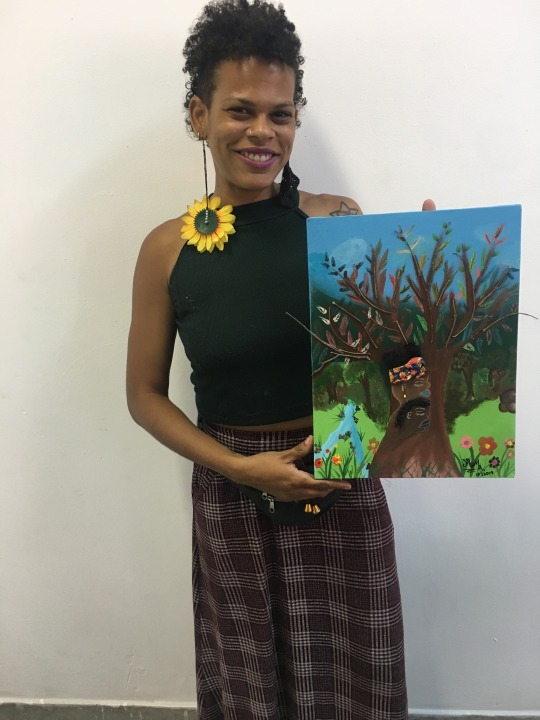
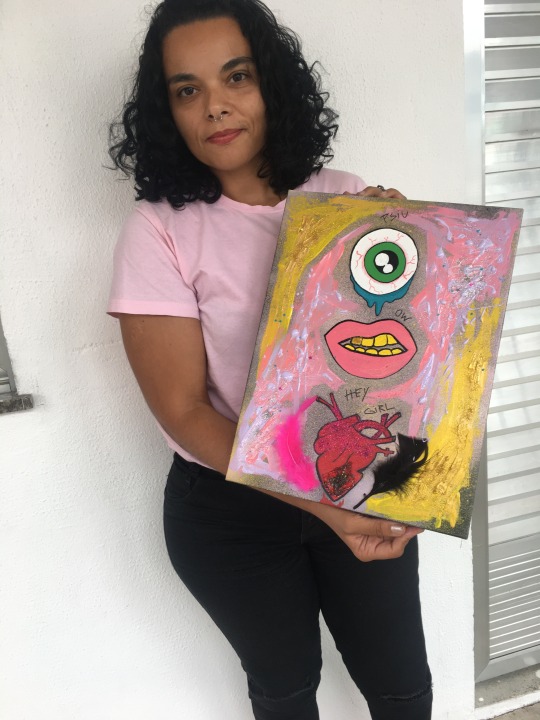
Local: Arena Carioca Jovelina Pérola Negra – Pavuna
Oficina: Pintura de tela
Equipe: Fernanda Vale
Fotos: Priscila Rooxo
Data: 26/10/2019
Número total de participantes: 17
Nome das participantes: Aine Rocha, Ana Carolina Gomes, Ana Paula Pereira, Bruna Cerqueira, Claudia Oliveira dos Santos, Edilene Oliveira, Karina Romano, Luanda Santana, Maria Luiza Rosa, Mariana Machado, Nara Conceição, Sara Gomes, Tâmara de Souza, Thais Santana, Thaiza Santos, Thalita Maciel e Thamires Soares.
2 notes
·
View notes
Photo
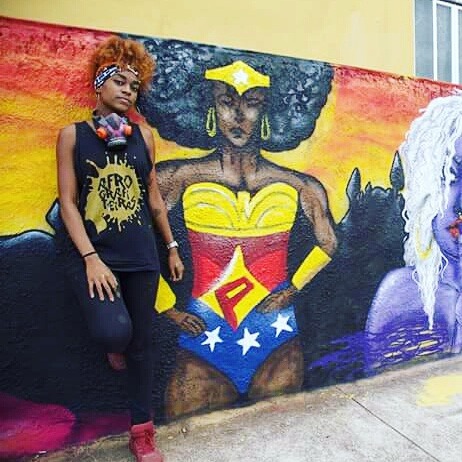
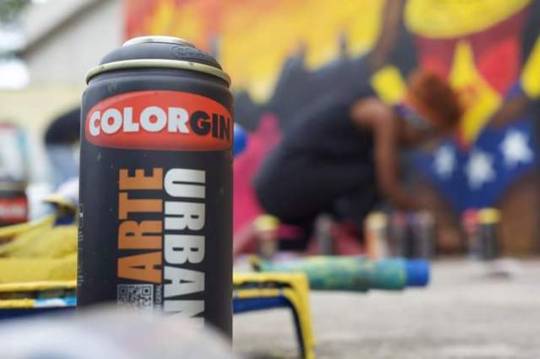

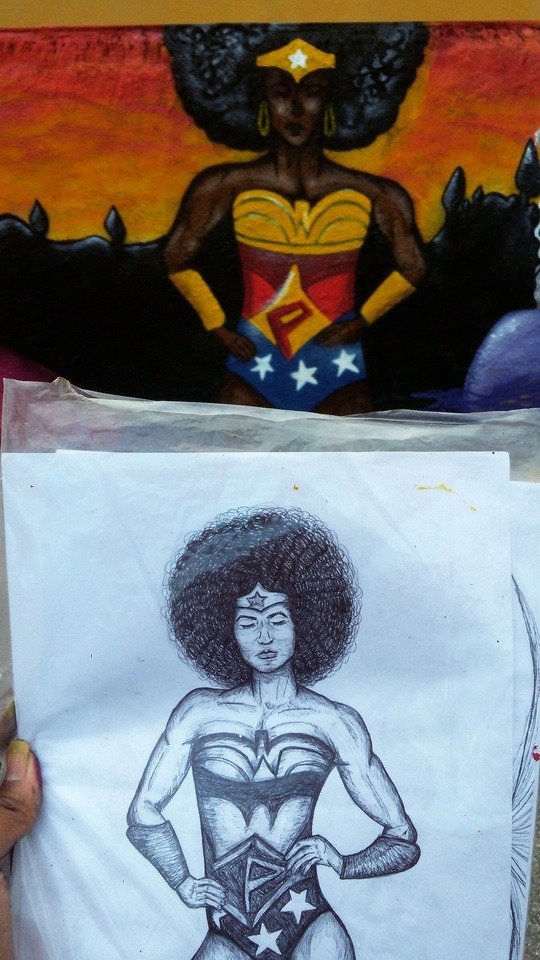
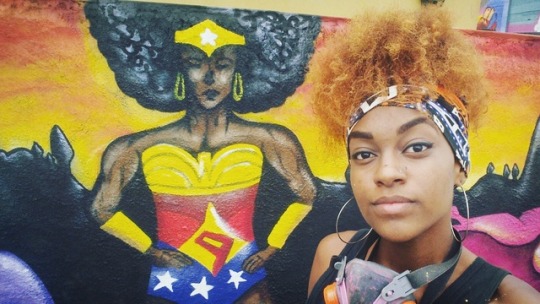
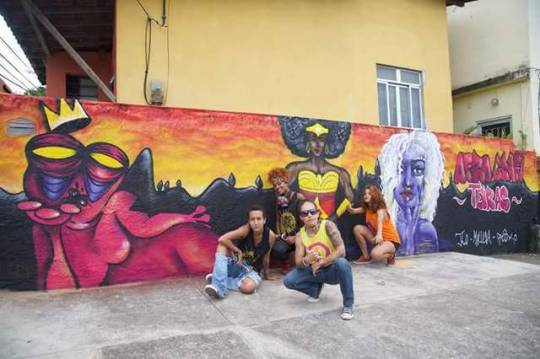
Pintura feita na Comunidade Tavares Bastos - Rio de Janeiro. Em conjunto com Jlo Borges e Priscila Rooxo. #AfroGrafiteiras #TavaresBastos #RedeNami #arteurbana #graffitirj #streetartrio
1 note
·
View note
Photo

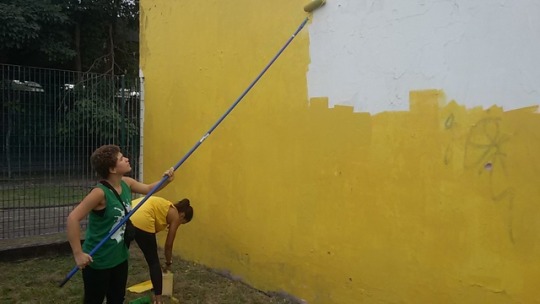
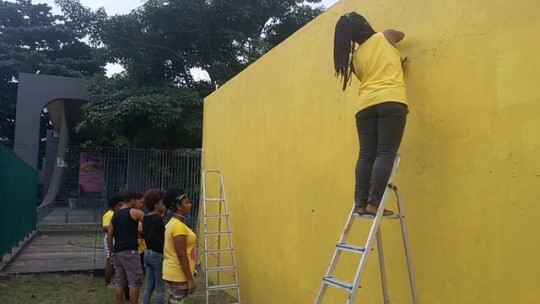


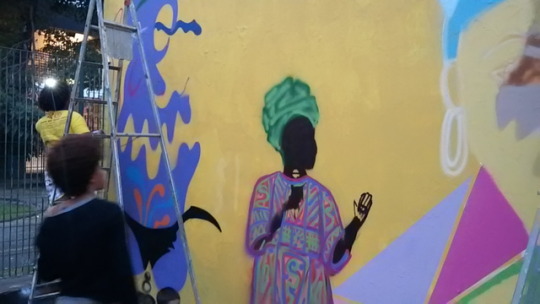
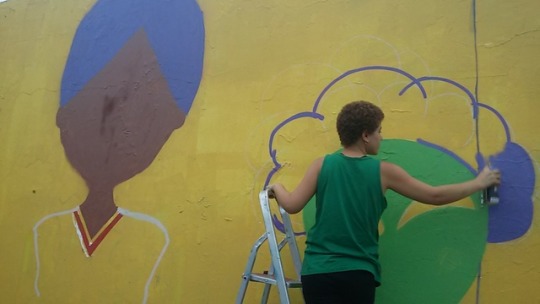

Na penúltima oficina #AfroGrafiteiras #ClaraNunes, as meninas finalizaram as pinturas em tela e iniciaram a feitura do graffiti final. Nesta aula contamos com a presença do artista e grafiteiro Kadu Ori, que deu todo apoio e orientação para este mural coletivo.
4 notes
·
View notes
Photo

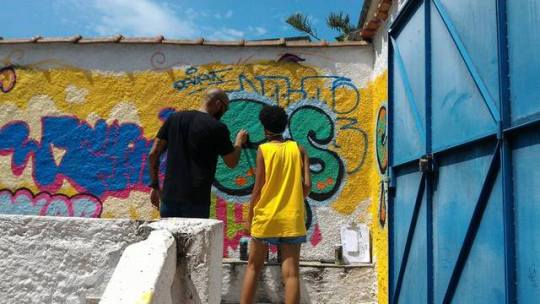
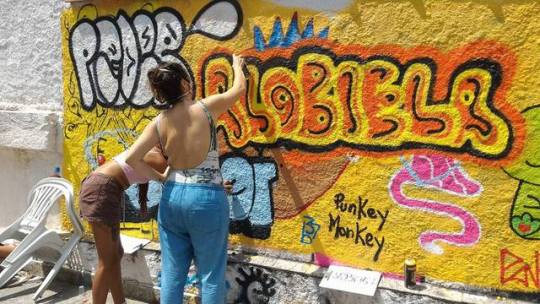

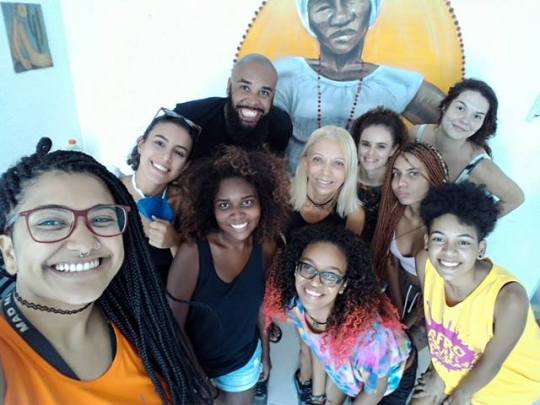
No último sábado as #Afrografiteiras se reuniram pra aprender um pouco mais sobre bomber, com oPoder-Afro, relíquia do grafitti
O bomber é uma vertente do grafitti que é mais ágil e procura gastar menos tinta
O bomber é muito usado nas ruas, no vandal, normalmente sem autorização
Você pode usar texturas, sombra e luz e outras técnicas, mas sempre buscando a simplicidade pra ser mais ágil
Valeu, Pablo!
1 note
·
View note
Text
Panmela Castro: Brazil’s graffiti queen, delivering justice through the nozzle of a paint can
(CNN)“I was a victim, but that was a very long time ago.”
Panmela Castro casts her mind back to the day she was beaten.
Like her mother, like her aunts, like many of her friends, the Rio de Janeiro native had become a statistic within an epidemic of violence against women.
Castro remembers going to the police, but there was no law to back her up — at the time, domestic abuse was not a crime in Brazil. The incident was a private matter Castro was told, and no charges were filed.
She says psychological attacks had started shortly after she moved in with her partner. At the time she did not identify it as a form of abuse, but Castro claims the single violent incident was the final straw. She walked away, an act of defiance against Brazil’s cultural landscape, where countless women suffer in silence.
She had become a victim, but would not continue as one.
A trained artist educated at the University of Rio de Janeiro, Castro had been tagging walls using the nom de guerre “Anarkia Boladona”, but now she found herself painting more and more.
Castro recalls how her ex-partner would harass her when she left the house, but creating graffiti with fellow artists, who were overwhelmingly male, offered her a level of protection.
Unlike the calligraphy or macho symbols daubed throughout Rio, Castro’s work was feminine. Something of substance. Something empowering.
A relationship had ended but she’d found her voice.
Now Castro is helping a nation of women find theirs.
A global problem
Globally, 35% of women have experience physical and/or sexual violence in their life, according to the World Health Organization — and for 30% it was at the hands of their partner. In Brazil the problem was particularly acute, allowed to metastasize for generations, with no legal recourse for victims.
It took the case of Maria da Penha to shock policymakers into action. Da Penha’s husband had tried to kill her twice. In May 1983, he shot her in her sleep, leaving her paraplegic and hospitalized. A fortnight after his wife’s return home, he tried to electrocute her in the shower.
Tried and found guilty, he twice successfully appealed. Eventually in 2002 de Penha’s husband was convicted and sentenced to eight years in prison, but walked free after serving a fraction of his sentence.
A two decade-long legal suit filed by da Penha finally resulted in a landmark ruling, taking the Brazilian government to task for failing to prosecute perpetrators of domestic violence to the necessary degree. In August 2006, Federal Brazilian Law 11.340./06, known as the “Maria da Penha Law,” was brought into effect by Luiz Incio Lula da Silva’s government.
Mural commemorating the 8th anniversary of the Maria da Penha law, Rio de Janiero.
The law was not a panacea. It resulted in 331,000 prosecutions and 110,000 final judgments in its first five years, according to the National Council of Justice of Brazil, per UN Women. However, in a country where 41,532 women were murdered between 1997 and 2007, and 10 women were dying every day from domestic violence, systemic abuse was never going to stop overnight.
The new law needed help reaching the people most effected.
Panmela Castro was at hand.
Outlier
The artist turned professional in 2005, and after the summer of 2006 began collaborating with organization Com Causa (“With Cause”), campaigning for women’s rights and publicizing the new law.
“It was easy for me because I knew these streets,” Castro tells CNN.
As a female urban artist Castro was an outlier.
“In order to be accepted you have to pay a high price, because it’s very difficult for women to get into those sorts of groups,” she reflects. “(Men) don’t like the idea of sharing power and being equals with women.”
Despite male graffiti artistsoffering her a form of protection when she was finding her feet, Castro maintains that even today she suffers psychological abuse and sexual harassment from her male counterparts at times.
“One of the reasons I was accepted was because I was good at what I did — internationally renowned … They were forced to accept me.”
There’s a reason Castro has been dubbed “Brazil’s graffiti queen.”
Her murals, low on words but heavy on message, are things of beauty. Often featuring portraits of women, they’re feminine without sexualizing the female body. Sisterhood is frequently suggested in her figures’ intertwined hair, while mythical characters like the goddess Liberty look out across Rio. The biblical Eve, “that unreliable and treacherous woman,” as Castro drolly refers to her, is a mainstay.
Through Castro’s work, women are occupying public spaces in Brazil, reclaiming the streets.
Look close enough and in the corner of one Castro mural you can find an allusion to “vagina dentata” — a folk tale in which a woman’s vagina contains teeth.
The message is clear: this woman bites back.
Spreading the word
There is a limit to what paint alone can do, says the artist.
“My graffiti is talking about justice, violence, women’s advocacy,” Castro says, “but it’s not (going) to make a real change.” Her art has, however, given her a platform to launch what has become her main pursuit: Rede Nami.
Rede Nami was started by Castro in 2010 as a way to educate communities on domestic violence by running workshops for mixed groups of 14-19 year olds, and others for women of any age.
After spending an hour discussing women’s rights, and sometimes sharing experiences of abuse, the group uses the rest of the workshop to create a mural visualizing the issue — it is physical evidence that citizens are taking a stand.
Children painting a mural during one of Rede Nami’s workshops.
“You can’t really entice people to just talk about their cases,” Castro says. “The graffiti is what makes them want to share. If it was just conversation, people wouldn’t come.”
Over 5,000 people have participated in the workshops so far, some taking place outside Brazil, while the initiative has received support from Amnesty International, Vital Voices and the Brazil Foundation.
Rede Nami has also created a program called AfroGrafiteiras, currently educating 180 Afro-Brazilian women about black feminism, gender and their own rights — as well as training them as street artists.
“All these themes help to fight the macho movement,” she adds.
Celebrity Castro
The initiative has brought Castro celebrity in Brazil, and she’s received numerous global accolades. Listed as one of Newsweek’s 150 Women Who Shake the World and noted as a Young Global Leader by the World Economic Forum, Castro can be found hobnobbing with influencers including Diane Von Furstenberg, Oprah Winfrey and Jessica Alba, as well as Brazil’s most famous son, Pele.
She’s been commissioned across the Americas and in Europe by the likes of Nike, Hublot and Avon.
Recently one of her murals in New York featured prominently in coverage of the Women’s March on January 21, she says. A classic Castro design, it depicted two women joined by braided hair, with the message “Women’s Rights are Human Rights.”
Castro’s mural outside Urban Nation, due to open September 2017. (Image: Courtesy Urban Nation)
She describes a vast faade she has made for the upcoming Urban Nation gallery in Berlin (opening September 2017) as “one of my most special works.”
Performance art
In recent years, Castro has diversified into the field of performance art.
Carrying the flame of the Yugoslavia-born so-called “grandmother of performance art” Marina Abramovic and others, the new medium has allowed her to venture into transgressive territory in a way that her workshops cannot.
A post shared by My life for lovely stalkers (@panmelacastro) on Jul 10, 2016 at 6:24am PDT
For example, in a 2016 performance entitled “Por que?” (“Why?”), Castro — wearing an ostentatious Von Fustemberg dress — carved the title of the piece into her flesh. A similar bloody inscription materialized in “Gentileza Gera Gentileza” (“Kindness Generates Kindness”), when that maxim was etched into her back with a surgical scalpel.
Perhaps Castro’s most visceral act came in 2015. For the past four years she had been incorporating apples into her work, sometimes superimposing a vulva on the fruit, as an allusion to Eve.
Eve’s apple became a permanent fixture for Castro when she had one tattooed on her arm during a piece called “Ruptura,” performed as part of the “Eva” show at the Scenarium Gallery in Rio de Janeiro. The performance began with Castro applying lipstick, before being tattooed, having her head shaved by the audience, and changing into a sharp black suit. (Watch the whole performance here.)
Priscila Duarte, curator of “Eva” and consultant director of Rede Nami, described the performance’s intent: “Panmela breaks with the appearance of the princess girl, the good girl to marry and the exemplary daughter, to become another image that we can no longer define so much, but which I interpret as Renaissance.”
“When we talk about gender, we’re talking about freedom for people to deconstruct their status as women,” Castro explains. But gender, she argues, has become a forbidden word in Brazil’s classrooms. It means there has to be a clear distinction between her output as an artist, and her educational work for RedeNami.
“Most of the dialogue against women happens because people think that women have to be lower (than men). We think that women can be anything they want.”
Fortunately, the teenagers Castro educates, she says, are from a generation “open to learning and respecting women.”
“Before you’d have to fight for your rights, fight to be protected,” she says. “Today you fight to maintain those laws.”
Armed with a spray can and an indomitable persona, it’s hard to imagine Castro anywhere but the frontlines.
Read more: http://cnn.it/2mNrInF
from Panmela Castro: Brazil’s graffiti queen, delivering justice through the nozzle of a paint can
0 notes
Photo
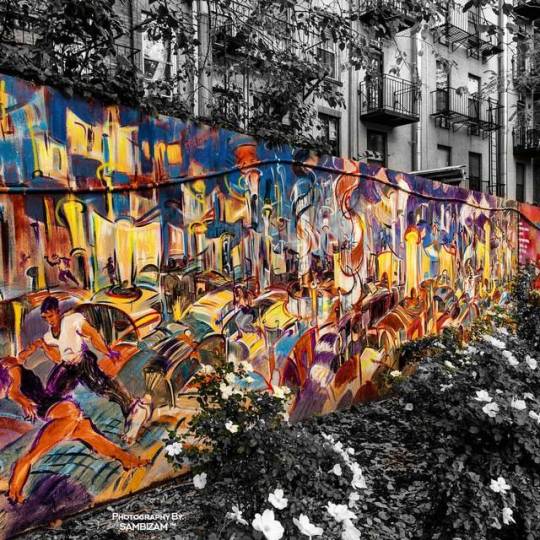
NEW YORK IS ART . #afrografiteiras . #nycstreetphotography #makatron #Graphitiart #circa2015 #streetart #nyc #artisnewyork #artislife
#makatron#graphitiart#artislife#nycstreetphotography#artisnewyork#streetart#circa2015#nyc#afrografiteiras
0 notes